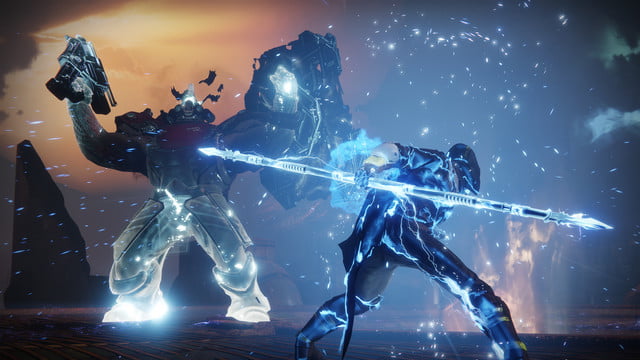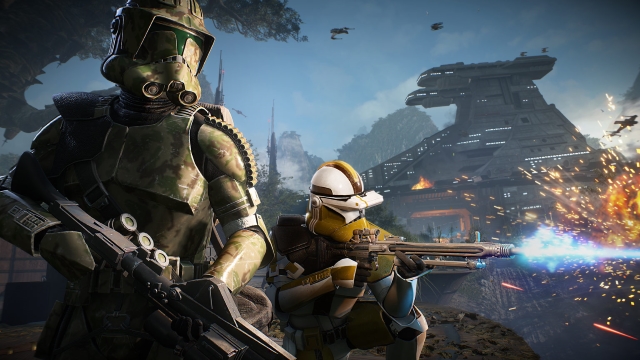News has broken this week that EA is laying off 350 members of staff. This comes in the wake of a number of controversies for the publisher, the vast majority of which have revolved around its employment of the Games as a Service (GaaS) or “live service games” business model. Underwhelming releases such as Anthem and Star Wars Battlefront 2 have put a dent in the reputation of the publisher and its associated development teams, with its desire to cultivate IPs that will rake in the cash over an extended period of time leading to repeated controversies.
The allure of Games as a Service/live games for publishers like EA is clear; rather than dividing up resources between various different development teams working on a bunch of projects, they can instead invest that money into one blockbuster game that will (in theory) remain profitable over an extended period of time. This game can then be updated and improved as months and years go by, with monetization options such as microtransactions and other DLC keeping the revenue rolling in.
One such example of a live game is Anthem. BioWare’s latest release had a disappointing launch, with it falling below consumer expectations. While fellow live game The Division 2 has fared better in terms of its reviews, UK sales data released following its launch revealed that physical sales are just 20 percent of what was achieved by its predecessor. No matter how you slice it, two of this year’s hottest live games haven’t been as impactful as their creators would have hoped.
GaaS is an increasingly popular business model that pushes games as a continuing source of revenue, rather than a one-time purchase. Unfortunately, the reality is that developing a game that remains interesting even after a few months is a grand undertaking. First, developers need to release something that is immediately gripping and features enough content to last players until its next update. Then, microtransactions will inevitably be deployed that will need to remain lucrative while not inciting riots. Finally, the devs need to release an update that will convince players to either part with more of their spare time or, optimistically, more cash.
Why it’s so difficult for live games to succeed

The success of live games isn’t in their launch numbers, but rather their retention rate. Anthem was the best-selling game in February according to NPD sales data, beating out other big releases such as Far Cry New Dawn and Metro Exodus. However, it’s also one of few major games published by EA until its reliably successful sports titles later in the year. Anthem‘s current player numbers are unclear, but with consumer reception being overwhelmingly negative, it will have likely experienced a significant decrease.
Were it not for the unexpected bank-rolling success of Apex Legends, this would have left EA in a tough spot in early 2019. Publishers now push out fewer games per year in favor of being reliant on a handful of major releases, which they then hope will carry them to continued profits over a number of years.

As noted in my feature on the Activision Blizzard layoffs, in 2016, ’17, and ’18 the publisher’s previously extensive lineup of new releases was limited to a maximum of five new games per year. Compare that to 2012, in which Activision pushed out a whopping 19 games, and it’s clear to see the direction in which the industry is headed. Now publishers put more emphasis than ever on the performance of individual games, leading to increasingly huge staff turnovers due to shareholders’ lofty expectations not being met when a single game doesn’t hit its targets.
This means that while Anthem may have had stronger launch month sales than its competitors, it isn’t held to the same metric of success as Metro Exodus. Whereas the latter is a single-player game where the only thing that matters is the number of units it shifts, Anthem needs to keep players funneling money into it for a considerable amount of time before it’s not considered a failure. Even if Anthem is moderately popular, it will be considered an abject failure by an industry that wants every live game to keep their pockets lined for the next 2–3 years.
The EA layoffs

While Anthem obviously isn’t solely responsible for EA’s layoffs, it’s clear that its underwhelming attempts at live games haven’t helped its situation. In an email to employees reportedly obtained by Kotaku, EA boss Andrew Wilson wrote: “We have a vision to be the World’s Greatest Games Company. If we’re honest with ourselves, we’re not there right now. We have work to do with our games, our player relationships, and our business.
“Across the company, teams are already taking action to ensure we are creating higher-quality games and live services, reaching more platforms with our content and subscriptions, improving our Frostbite tools, focusing our network and cloud gaming priorities, and closing the gap between us and our player communities.”
Considering that all of EA’s recent controversies are tied into its urge to create more live games — from shuttering Visceral games and canning its linear, story-driven Star Wars project, through to it stopping the sale of FIFA Points in Belgium following governmental pressure — it’s clear that something is deeply wrong with the Games as a Service obsession.
Players don’t trust Games as a Service

Unfortunately for publishers, it’s now impossible to sell live games without players becoming suspicious. Over the past few years, we’re seeing many more games adopt this model, but we’ve also seen players becoming more aware of what this model entails and choosing not to fall into the same trap. Too often do GaaS launch with minimal content, yet players are expected to jump into a sub-par experience on day one, with avenues for monetization prioritized over the quality of the games. This then leads to the market becoming warier of other live games, harming the potential success of future GaaS.
For example, Destiny and The Division both underwhelmed on release, though over the course of several updates they became much better games. But how do these games and their disappointing launches convince players to invest in their sequels? After Destiny only began to match many players’ expectations after several expansions, how could Bungie and publisher Activision convince players to invest in Destiny 2 on day one?
Destiny 2‘s sales didn’t match Activision’s nor its investors’ expectations, with the game having more pernicious microtransactions shoveled into it as a result. This divided its player base even more, as Activision attempted to generate the profit necessary to appease its shareholders. Activision eventually announced mass layoffs due to its underwhelming 2018 and its poor outlook for 2019.
Rainbow Six: Siege and how to do live games properly

Considering that Activision Blizzard is now overwhelmingly reliant on the success of live games, these layoffs are indicative of what happens when they don’t perform to expectations. Despite the publisher actually reporting record profits for the fiscal year 2018, it still wasn’t enough to match its lofty internal targets.
Compare this to Ubisoft, which also reported profits in 2018, yet didn’t accompany that news with extensive staff layoffs. Ubisoft attributed much of its success last year to the strong performance of Assassin’s Creed Odyssey and Far Cry 5, two single-player-focused games that are a complete contrast to the kinds of games that Activision Blizzard prioritizes.
It has also created one of the most successful live games to date in the form of Rainbow Six: Siege, which released in 2015 yet still remains in Steam’s top 10 most-played games. Like many live games, Siege released with minimal content and was widely criticized as a result. Ubisoft responded to these complaints by way of releasing a stream of free DLC, which didn’t divide up the game’s player base like most expansions, and made its microtransactions and season pass less divisive as a result.
No one wants to feel cheated

Players don’t want to feel like they’re being cheated. Siege is the perfect example of a live game that struggled out of the gate, acknowledged criticisms and adapted to what its consumers wanted from it, then set about directly catering to its audience. Ubisoft reported earlier this year that Siege‘s revenue and monthly players were up year-over-year, with it recording $440 million in revenue in 2018 (via GamesIndustry.biz). This is a huge accomplishment for a game that released over three years ago.
No Man’s Sky is another example of a successful live game. Perhaps the most controversial video game release of all time, Hello Games has spent all its time since launch restoring consumer trust, launching a variety of impressive free updates that keep players coming in. Funding could have easily been pulled from No Man’s Sky and it would have remained an infamous failure, but now it has rolled out proper co-op multiplayer and has full VR support coming soon.
Not every live service game is going to be a success. Not every game that struggles at launch is going to be able to turn it around by way of issuing frequent updates. Unfortunately, the gaming industry’s top publishers and their obsession with live games are forcing this to be the case. How many more layoffs are going to take place after a publisher has put all of its eggs into the GaaS basket? Hopefully, EA’s comments that it’s looking to close the gap between its corporate ambitions and player expectations will bear fruit in the future.







